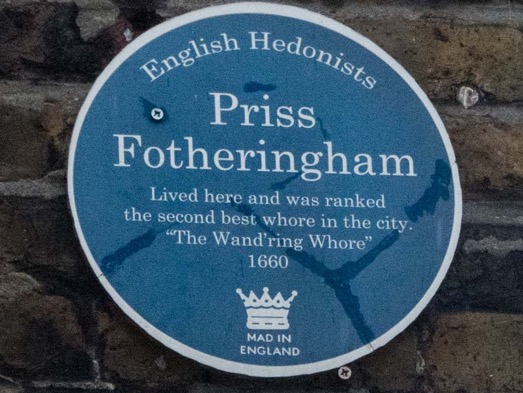The above blue plaque in Whitecross Street, Finsbury, has recently been obscured by a new artwork. Whilst sad that we can no longer see it, the plaque itself was part of a contemporary artwork series installed in 2012 during the annual Whitecross festival of street art. At a cursory glance, the plaque might be a familiar blue English Heritage one, but a closer look reveals English Hedonists and Mad in England. The Hedonists were an art collective who created the historical plaque series, including two others still visible in the street commemorating the 19th century Whitecross Street Market and nearby Debtors Prison.
So who was Priss? She was born around 1615 as Priscilla Carsewell, worked as a prostitute, was described as a ’notorious strumpet’ and married into the Fotheringham family of brothel keepers. Her husband was 10 or more years younger than her, was also her pimp and reputedly violent. She was described in 1652 by parish officers who entered a suspect establishment as “sitting between two Dutchmen with her breasts naked to the waist and without stockings, drinking and singing in a very uncivil manner”. In time, Priss, who had been described as attractive when younger, caught smallpox and lost her looks – worsened by the quack cures of the time such as bathing in mercury – and then contracted syphilis.
Things appeared even grimmer when she stole from her husband and ran away, but was caught and sentenced to a year in Newgate prison.Prison, however, became her educator and saviour, because here she met two of the great brothel keepers of the day, Mrs Cresswell and Damarose (sometimes spelled Damaris) Page. In the mid 1600s, business opportunities for women were limited but these two were highly successful, enterprising and taught Priss how to become a procurer, teacher, collaborator and organising ‘madame’ like themselves.
Another prison inmate was the writer John Garfield, who chronicled the prostitution business in his pamphlet ’The Wandering Whore’, where he ranked Priss second only to the ‘Great Bawd’ Damarose. Both Mrs Cresswell and Damarose ran multiple businesses aimed at different classes of customers, although Mrs Cresswell’s establishments were mostly more upmarket and her Moorgate rooms were endorsed by King Charles II. Damarose ran a brothel for seamen in Wapping but also imported the most expensive and expert prostitutes in the business from Venice.
Priss ran the Six Windmills in Moorfields, known also as ‘Priscilla Fotheringham’s Chucking Office’. Here she showcased a novelty act, which involved the ‘chucking’ of cash into an opening and is perhaps too debauched to describe fully here – but do google it! She taught her girls to do this famous and astonishingly lucrative trick, with customers showering the performers with coins of all denominations. Priss also forged links with a complementary business in Smithfield known as the ‘Prick Office’.
She died around 1668, a victim of advanced syphilis but by then extremely wealthy. She was remembered in ballad, song and by this epitaph: “Money and Cunny are Good Commodities”!!
For a rather jolly romp through London’s history from a bawdy perspective, see if you can find a copy of ‘London, the Sinful City’ by E.J. Burford – currently (early 2023) available at Abe Books and Amazon. Look out for my next walk around Finsbury to hear more stories of this fascinating area.

